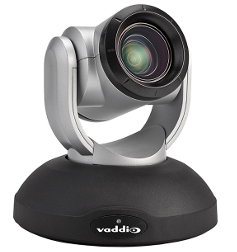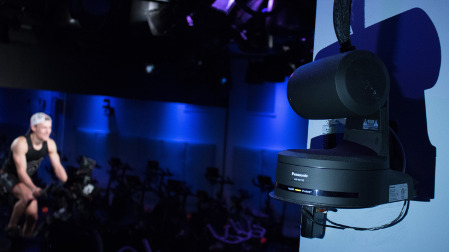PTZ Cameras Gaining Ground in Broadcast
(The teleprompting section of this article has been updated)
SEATTLE—As someone with decades of television station experience, I have to admit that I never thought I’d see the day when a television studio would be populated by cameras that look like the ghosts Inky, Clyde, Blinky and Pinky from the Pac-Man video game.
LARGE MARKETS TAKING NOTICE
But PTZs, aka pan-tilt-zoom cameras, are finding more acceptance at call-letter stations and other applications. The reason is simple, according to Richie Murray, founder and CEO of Bridge Digital, a Nashville, Tenn.-based media systems integrator. “If you’re looking to automate, cut costs and bring good quality video to the organization, then they’re a godsend,” he said.

Vaddio RoboSHOT 20 UHD
Mark Siegel, president of systems integrator Advanced Broadcast Solutions in Seattle, agrees. “For the cost of a traditional HD camera and lens that’s in the $40,000 range, you can get five PTZ HD cameras that cost less than $8,000 each.”
His company first put PTZs in a small market station five years ago, partially because of the PTZ’s low capital cost and partially for the operational savings by eliminating camera operators. He said that large-market stations have taken notice.
“[Broadcast station group] Tegna pulled out robots that mounted ENG style cameras and started putting in PTZ-type cameras,” Siegel said, adding that they’re able to install more cameras in the facility, which reduces the need to move cameras across the studio. “You can create more different views and you don’t have robots ‘X, Y and Z-ing’ all over the studio, which are costly to maintain, costly to operate.��� They do use a televator system to raise and lower the PTZs.
LOW LIGHT
Peloton Cycling, a New York-based developer of exercise bicycles, approached Bridge Digital’s Murray for a non-news studio that nonetheless needed high-quality video for around-the-clock operation. The PTZ cameras are critical components for a state-of-the-industry fitness studio that live streams 14 classes daily. A user base of more than 180,000 cyclists mount their Peloton large flat screen-equipped exercise bikes to pedal to commands from world class spin class instructors.
The 8,000 square-foot studio—with room for a squad of riders pedaling along with the leader—is equipped with four PTZ cameras. Three of them are mounted in strategical positions with the fourth mounted on an overhead track system.

One of the reasons Peloton selected PTZ cameras for its livestreaming cycling video service is the cameras’ ability to work in low-light situations.
“One of the customer’s requirements was that the PTZ cameras needed low-light capability, because the spin classes that Peloton Cycle puts on are done in relatively low light.” Low light capability is part of a PTZ’s DNA because of their linage: their ancestors were security cameras.
“PTZ cameras don’t come out of traditional broadcast camera development,” said ABS’s Siegle. “They come out of the security divisions of various camera manufacturers. So they’ve taken security technology and brought them into broadcast.”
LENSE SHORTCOMINGS
Where PTZ cameras will be mixed in a studio with ENG or box-type cameras with broadcast lenses, there’s the issue of matching them up. “Believe it or not, in some environments a PTZ will outperform a traditional camera because they’ve got better low light sensitivity,” Siegel said.
He pointed to the difference in lenses as a weakness of PTZs. “You can’t compare a broadcast HD lens that costs $40,000 with a piece of three-element PTZ optical glass, which probably costs the manufacturer $75 or $100. The glass just isn’t there for an all-in-one PTZ.”
Siegel pointed to another issue with PTZ camera lenses. “The majority of PTZs manufactured have 20x lenses. Now for broadcast news studio purposes that’s okay, because you’ve only got 15 to 25-foot throws.
“When you start getting into houses of worship, sports and anything like them in a live event, you’ve got to be really conscious of the distance,” Siegel continued. “They can require longer throw lenses, optically 30x lenses. And along with the longer zoom range, image stabilization is necessary because when you get a lens throwing out that far, it’s got to be stable.”
TELEPROMPTER CONSIDERATIONS
A final component that might be taken for granted at first glance is the teleprompter. A manned camera, or ENG-style camera mounted on a substantial robotic pan and tilt head, can pivot and tilt the prompter along with the camera head. It’s not so simple with the PTZ.
There are several problems. One is that the panning motor and gearing is designed to smoothly operate with only the PTZ itself to move. A prompter fastened onto the PTZ housing could double that load, requiring larger, specially built motors and gearing.
A second problem is with the PTZ’s lens. Simply put, there’s not much of the lens to attach the prompter to. This means the prompter can’t tilt along with the lens. One workaround for this is a new teleprompting system from Cuescript that mounts the prompter below the PTZ camera, which is inverted. This provides for more camera panning and tilting.
Another solution is to supply a large enough prompter mirror and display assembly that allows limited panning and tilting before the prompter begins to vignette the PTZ’s shot. Telescript International designed a PTZ prompter that can be placed in an erected position when the news anchor is reading the script, but folds down and out of the way when a wide or panning shot is required. Expect to see more evolution in PTZ prompters in the days ahead.
Vaddio, a Minneapolis-based PTZ and robotic camera system builder, provides a helpful worksheet titled “Choose Your Camera” at www.vaddio.com. It helps guide a customer through questions about the environment where the PTZ will work, is it a large or small room, how much light is available, how long a lens is needed, what kind of video outputs are required, and so forth.
Get the TV Tech Newsletter
The professional video industry's #1 source for news, trends and product and tech information. Sign up below.
